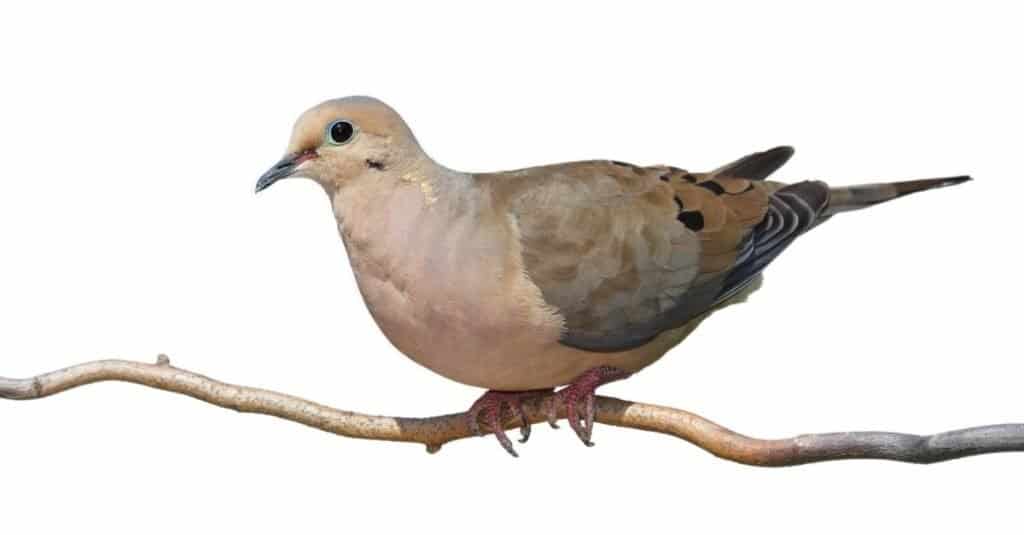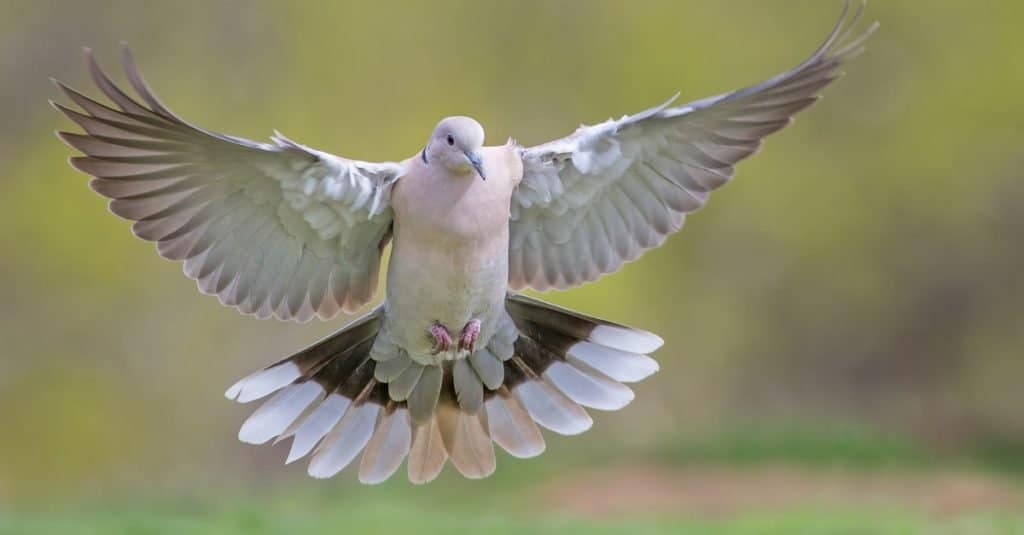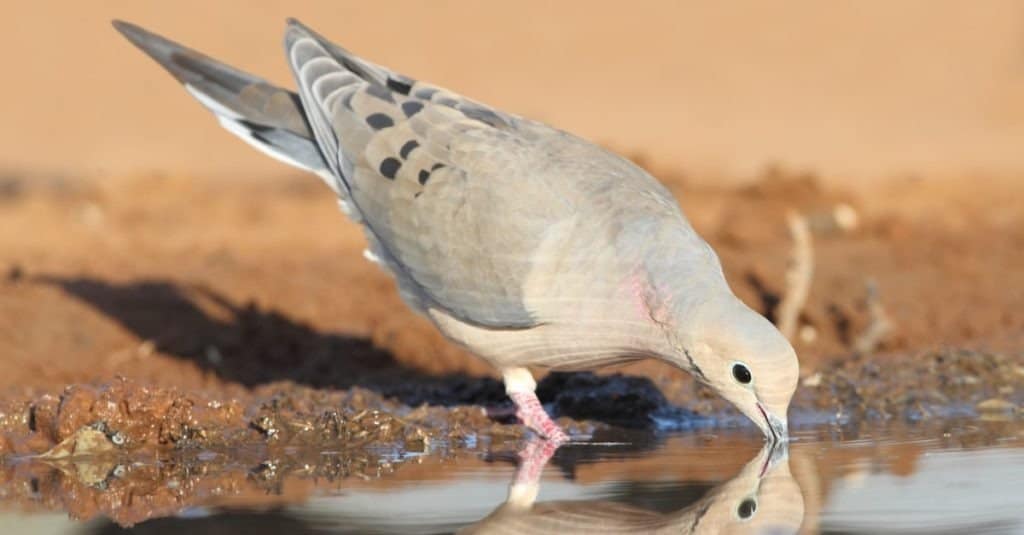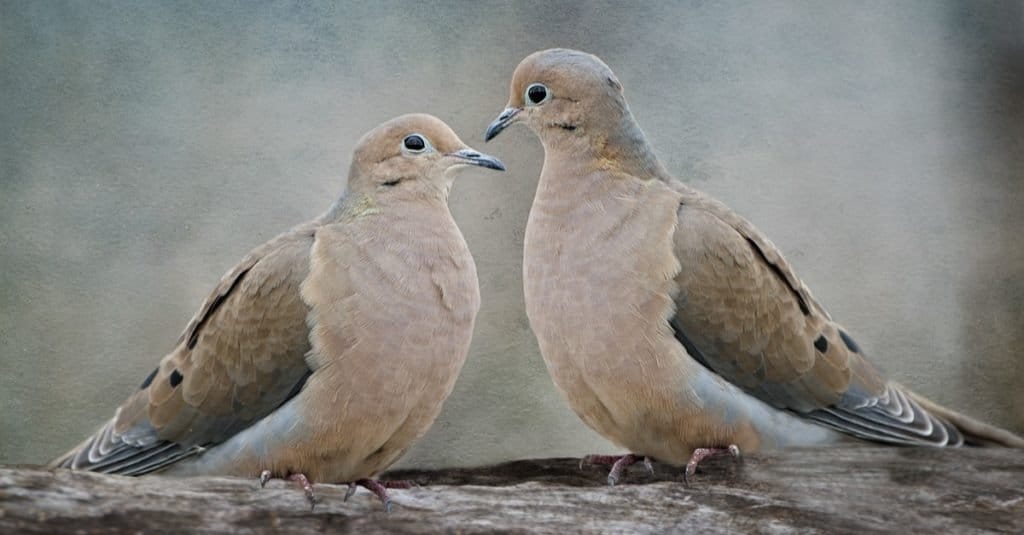Have you ever heard the distinctive “hoot hoot” call of an owl? It’s one of the most well-known and cherished of all bird calls. That said, not all hoots sound alike, and their hoots can convey different meanings. Owls hoot to mark their territory and warn potential competitors to stay away. At times, owls also hoot if they detect the presence of a predator, such as a wildcat, eagle, or snake. Mated owl pairs may use a special type of hoot to communicate with each other in a form of secret lovers’ language. As nocturnal hunters, you’re most likely to hear an owl hooting at night from the branch of a nearby tree. However, what if it’s daytime, and you hear that familiar hooting sound coming from outside your window? Could it be another bird that sounds like an owl? After all, most owls are nocturnal, and only the northern hawk owl and pygmy owls primarily hunt during the day. Given that, what bird is the source of that familiar hooting?
Meet the mourning dove, the bird that sounds like an owl. Also known as the turtle dove or Carolina pigeon, the mourning dove is a common sight throughout North America. In this article, we’ll discuss their taxonomy, distribution and habitat, physical characteristics, social and mating behavior, diet and feeding behavior, and ecological and cultural importance. Furthermore, we’ll also discuss how you can tell a mourning dove call apart from an owl call. In the end, we’ll also answer some frequently asked questions about mourning doves to cover anything we’ve missed. Let’s dive into our discussion of the mourning dove.
Taxonomy

The mourning dove is closely related to the now-extinct passenger pigeon.
©Mike Truchon/Shutterstock.com
The mourning dove belongs to the Columbidae family of doves and pigeons. Its scientific name, Zenaida macroura, is a combination of two different languages. Zenaida refers to Zénaïde Laetitia Julie Bonaparte, the niece of Napoleon Bonaparte and wife of well known French ornithologist, Charles Lucien Bonaparte. Meanwhile, macroura comes from the Greek words makros or “long” and ouros or “tailed.” It’s a close relative of both the eared dove and Socorro dove. Furthermore, it shares close ties with the extinct passenger pigeon, and for years scientists grouped them into the same genus. Despite its name, it bears little kinship with the similarly named mourning collared dove native to Africa. To help differentiate the two, the mourning dove also goes by the name the American mourning dove. Currently, scientists recognize 5 different subspecies of the mourning dove.
Distribution and Habitat
Mourning doves live throughout the United States, Mexico, Central America, and parts of southern Canada. In addition, they live on many of the islands in the Caribbean including Bermuda, Cuba, Puerto Rico, and Costa Rica. Each of the five subspecies tends to live in distinct areas, although their ranges occasionally overlap. Most of the birds that live in Canada and the northern United States will migrate south for winter. On the other, those populations that live in warmer climates tend to be year-round residents. They make their homes in a wide variety of habitats, including urban areas, grasslands, and woodlands. Generally, they avoid wetland areas and dense forests. It’s common to find mourning doves living near humans, and they don’t appear overly bothered by the presence of people. They typically build their nests in trees, but also construct them in bushes, on buildings, or sometimes on the ground.
Physical Characteristics

The average mourning dove measures 12 inches long with a wingspan of 14.5 to 17.7 inches.
©Phoo Chan/Shutterstock.com
The mourning dove is a medium-sized bird that sounds like an owl. They typically measure around 12 inches long and sport a wingspan between 14.5 to 17.7 inches. Most specimens weigh around 4.5 ounces, but they can range between 4 to 6 ounces in the wild. Their wings are broad and elliptical-shaped, and their heads appear quite rounded. Mourning doves grow long, tapered tails, which serve as the basis for the second part of their scientific name, macroura. Like other perching birds and songbirds, three of their toes point forward, while one points backward. They grow a short, dark-colored beak, and relatively short, reddish legs. Common colors include light gray and brown, with black markings on the back and white on the tail. Males and females look very similar, although males also feature a bluish crest and pinkish patches on their necks.
Social and Mating Behavior
When not mating or raising young, mourning doves live together in large groups. On hot days, when not foraging for food, they may enjoy a birdbath or dust bath to cool. During the breeding seasons, males court females by noisily flapping their wings and puffing out their chests. Mourning doves mate for life, and the same pairs will raise multiple broods over successive breeding seasons. Males and females pick out nesting sites together. While the male helps to gather materials for the nest, only the female will construct it. Occasionally, mourning doves may take over an abandoned nest left by another dove, bird, or squirrel.
Female mourning doves almost exclusively lay two eggs per brood. Males and females take turns incubating the eggs, and will vigilantly watch over their nests and eggs. If threatened by a predator, adult mourning doves utilize a brilliant strategy to draw away attackers from their nests. One of the adults will fly away from the nest, and then act as if it has a broken wing. Once the predator takes the bait, it will then fly away from the nest in the hopes that the predator will follow. Once the eggs hatch, both parents will contribute to feeding the baby doves, or squabs. Squabs are fed pigeon’s milk, or crop milk, for the first few days after they hatch. Slowly, their diet will transition more to seeds. By the time they leave the nest around two weeks after birth, their diet is the same as their parents’.
Diet

The mourning dove’s diet consists of 99% seeds.
©iStock.com/BrianLasenby
While the mourning dove is a bird that sounds like an owl, it does not eat like an owl. The diet of the mourning dove is comprised almost entirely of seeds. Seeds make up 99% of their diet, although they will occasionally eat some insects. After stuffing their crops with seeds, they will fly away to a perch to digest. They may also eat fine dirt, sand, or small rocks, which help to aid their digestion. Mourning doves eat a wide variety of seeds including rapeseed, corn, safflower, millet, and sunflower seeds. That said, they tend to favor some seeds over others, and particularly enjoy corn, pine nuts, sesame, and wheat seeds.
Ecological and Cultural Importance
Due to their mostly vegetarian diet, mourning doves serve as important seed dispersers and pollinators. They help to distribute seeds of different plants over a large area and pollinate plants by digesting and defecating their seeds. In addition, they help to support predator populations including hawks, falcons, snakes, wildcats, and foxes. Culturally, mourning doves traditionally played an important role in the oral traditions of several Native American tribes. Internationally, they serve as a symbol of peace and love. Currently, the mourning dove ranks as Wisconsin’s official symbol of peace, and Michigan’s state bird of peach. It also serves as the national bird of the British Virgin Islands.
How to Tell an Owl Call From a Mourning Dove Call

Mourning doves make a number of distinctive calls that sound slightly different from an owl.
©Bonnie Taylor Barry/Shutterstock.com
The mourning dove is a bird that sounds like an owl, so it’s difficult to differentiate their calls, especially if you’re not familiar with them. That said, a few distinct features can help you to tell their vocalizations apart from one another. Typically, the male mourning dove makes a sound like “cooOOoo-wooooo-woo-woo,” made up of four parts. The first part sounds more like a trilling “coo,” followed by a long “woo” and two shorter “woos.” Other calls include a shorter “cooOOOoo” used when mated pairs meet each other, or a short “roo-oo” to warn of nearby predators. Meanwhile, owl calls generally sound sharper and less melodic. Many owl hoots can also sound like barks made up of quick, staccato “woos.” Others may emit single “hoos,” which again sound more guttural and deeper than the lighter, more airy “coos” or “woos” of the mourning dove.
Frequently Asked Questions About Mourning Doves

Mourning birds are one of the most common birds in North America.
©Todd Maertz/Shutterstock.com
How common are mourning doves?
Mourning doves rank as one of the most common birds in North America. Estimates of their total population hover around 475 million in any given year. That said, some populations may be in decline, due to lead poisoning and other environmental factors. Still, the IUCN currently lists the mourning dove as a species of Least Concern.
What animals eat mourning doves?
Predators that target mourning doves include snakes, cats, and hawks. In addition, some birds such as corvids and grackles will eat mourning dove eggs.
How fast is a mourning dove?
Mourning dives can move at a quick clip. Their broad, strong wings enable them to reach speeds up to 55 miles per hour.
The photo featured at the top of this post is © Jay Gao/Shutterstock.com
Thank you for reading! Have some feedback for us? Contact the AZ Animals editorial team.






